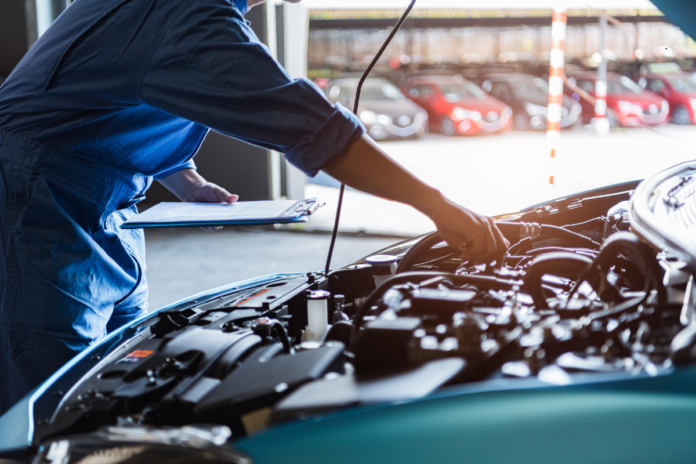Transmission fluid is the lifeblood of your car’s transmission, ensuring that the gears shift smoothly and efficiently. A leak in the transmission fluid is similar to a kink in your car’s vascular system, hindering its performance and potentially leading to serious damage. Recognizing a transmission fluid leak early can be the saving grace that prevents minor issues from escalating into major transmission problems.
Ignoring a transmission fluid leak is similar to ignoring a slow puncture on a tire; it’s a small issue that can lead to a larger problem. When left unaddressed, a leak can lead to transmission overheating, severe wear, and eventually, a costly repair or replacement. Understanding the high stakes involved in such seemingly minor issues is the first step towards maintaining a healthy car transmission and ensuring a long and trouble-free service life from your vehicle.
Early Detection: Spotting the Signs of a Transmission Leak
Puddles Under the Car
One of the most straightforward signs of a transmission leak is spotting puddles of fluid under your car. Transmission fluid has a distinctive red or pink hue, making it relatively easy to identify. Finding puddles in your usual parking spot is a clear indication that your transmission system may be leaking and needs attention.
The Smell of Trouble
Transmission fluid has a distinct smell, and when it’s leaking, it may come into contact with hot engine parts, producing a noticeable burning odor. This smell is not just unpleasant but a serious warning sign that your transmission fluid levels may be dangerously low. Recognizing this smell early and seeking a transmission repair service can prevent a minor leak from turning into a major headache.
Overheating
A common consequence of a transmission fluid leak is overheating. The fluid acts as a coolant for the transmission, and when its level drops, the transmission temperature can rise significantly. Overheating can lead to further damage, making it crucial to address the root cause of the overheating, which in many cases, is a fluid leak.
Shifting Issues
Transmission fluid is essential for the smooth operation of your car’s gear system. When the fluid level drops due to a leak, you may experience issues with shifting. These issues might include delayed gear engagement, hard or soft shifts, or even slipping gears. These shifting issues are subtle hints that your transmission fluid may be leaking and that a closer inspection is warranted.
Under the Hood: Unveiling Common Causes of Leaks
As your car ages, the seals within the transmission can degrade or become brittle, leading to leaks. These seals ensure that the transmission fluid stays contained within the system. Repairing degraded transmission seals is a crucial step towards stopping leaks and maintaining the integrity of the transmission system. Replacing old seals with new, high-quality ones can significantly extend the life of your transmission and prevent leaks from reoccurring.
The transmission pan, secured by bolts, is a common source of leaks, especially if the bolts become loose or the gasket that seals the pan gets damaged. Over time, these bolts can loosen due to the vibration and movement of the car. Regularly checking the tightness of these bolts and the condition of the pan gasket can prevent leaks. Additionally, if the pan gets dented, it can lead to a poor seal and eventual leaks, making it essential to replace or repair the pan when necessary.
The transmission fluid travels through lines that can become corroded or damaged over time, leading to leaks. These lines are usually made of steel or aluminum and are prone to rust, especially in harsh climates. Identifying and replacing components in fluid leak situations, such as damaged lines, is crucial for restoring the integrity of the transmission fluid system. Using high-quality materials for replacement can further ensure long-term reliability.
The importance of using the correct transmission fluid cannot be overstated. Different transmissions require specific types of fluid to operate correctly. Using the wrong fluid can cause the seals and gaskets within the transmission to degrade or fail, leading to leaks. Moreover, incorrect fluid can cause additional friction and heat, exacerbating the leak issue. Always refer to the vehicle’s owner’s manual or consult a professional to ensure the right type of fluid is used in your transmission.
DIY Diagnostics: Tracing the Source of the Leak
A visual inspection is the first step in diagnosing a transmission fluid leak. With the car safely elevated, inspect the transmission system for any obvious signs of leakage. Look for wet spots, drips, or puddles of red or pink fluid. Pay special attention to the transmission pan, seals, gaskets, and fluid lines. If you notice any damaged or corroded areas, these could be the sources of the leak.
The color and consistency of your transmission fluid can provide significant clues about the health of your transmission and the source of a leak. Fresh transmission fluid is typically red and transparent, while old or burnt fluid may appear dark and dirty. If you notice a change in the color or consistency of the fluid, it could indicate a leak or other internal transmission issues. Checking the fluid using a dipstick or a clean cloth can help you analyze its state.
Leak detection dyes are an excellent tool for tracing the source of a transmission fluid leak. Here’s a step-by-step guide on using them:
- Purchase the leak detection dye compatible with transmission fluid.
- With the engine off, add the dye to the transmission fluid through the fill tube.
- Run the engine and drive the car for a short distance to circulate the dye.
- Use a UV light to inspect the transmission system and the area underneath your car.
- The dye will glow, highlighting the exact location of the leak.
This method can help pinpoint even the smallest leaks, making it easier to address the problem effectively.
The paper test is a cost-effective and straightforward method to locate a transmission fluid leak. Place a large piece of cardboard or paper under your car overnight. In the morning, check for any wet spots on the paper. The location of the wet spots can help you identify the area of the leak. While it may not pinpoint the exact location, it can give you a good idea of where to start your investigation.
Proactive Protection: Preventive Measures for Transmission Leaks
Establishing a routine of regular check-ups can significantly reduce the risk of transmission leaks. These check-ups can include inspecting the transmission fluid level and color, checking for loose bolts, and examining the seals and gaskets for signs of wear or damage. By catching potential issues early, you can address them before they escalate into more significant problems, thereby maintaining a healthy car transmission.
Transmission leaks often manifest through performance issues like erratic shifting or transmission slipping. Paying immediate attention to such performance issues can be a form of preventive care. If you experience any unusual behavior from your vehicle, it’s advisable to check the transmission fluid levels and inspect for leaks. Addressing these concerns promptly can prevent further damage and extend the lifespan of your transmission.
While DIY checks are beneficial, having your vehicle serviced by a professional transmission repair service at regular intervals is crucial for maintaining its overall health. Professionals have the expertise and equipment to detect and fix minor issues before they become major problems. They can also replace worn-out components, change the transmission fluid, and ensure that your vehicle is operating efficiently.
Education is a powerful tool in preventing transmission leaks. Understanding the basic workings of your car’s transmission, knowing the signs of a potential leak, and learning how to perform simple checks can go a long way in preventing issues. Moreover, being educated on the importance of using the correct transmission fluid and knowing when to seek professional help can also contribute significantly to preventing transmission leaks.










